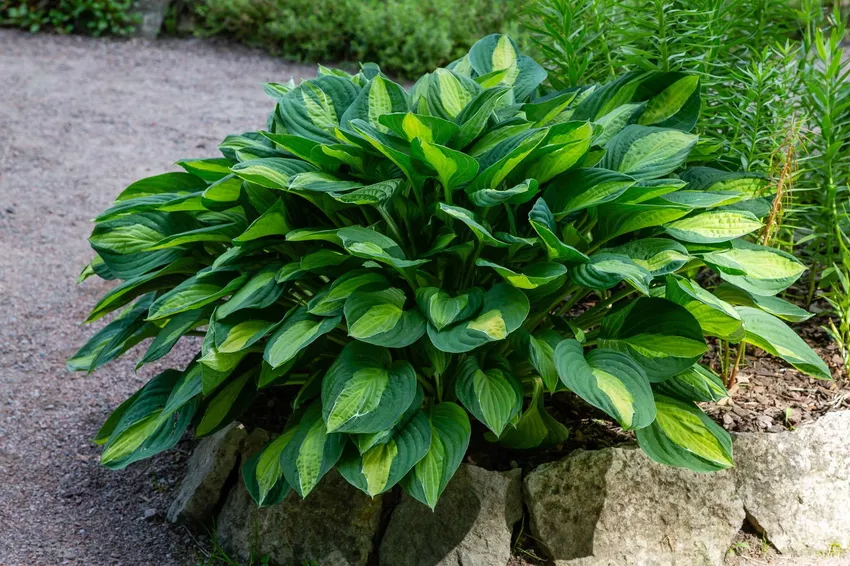The beautiful perennials have always been valued as ornamental plants. Here you can find out what you should consider when fertilizing hostas.

The first hostas (Hosta) came from Asia to Europe. A long way, but today the plants also enrich numerous gardens and parks in this country. The Hosta genus is comparatively young, which is why no fossils have yet been found.
The special thing about the Asian beauties is that they also thrive in the shade. And even when it comes to fertilization, hostas are pretty straightforward.
As an understory in the forests of Japan, China and Korea, the hosta is not only adapted to shade and moisture, but also to humus-rich soil, because forest soil is usually loose, permeable to water and humus. Hostas form rhizomes in the soil, a mixture of storage organ and root. These are usually short, branched and can temporarily store nutrients and sugar. So that the hosta can develop optimally in your garden, you should do everything to make the plant feel at home. The right substrate and the right fertilization are the crucial points here.
When do you fertilize hostas?
Funkias are very easy to care for when it comes to fertilizing. A gift should be made in the spring with a long-term fertilizer. Later, during the growth phase, fertilization is no longer necessary.

Fertilize hostas in the bed
In this case, fertilization is only necessary if the garden soil does not offer sufficient nutrients. With compost, manure or our Plantura organic universal fertilizer, the garden soil is upgraded for a long time.
Fertilize hostas in the pot
The easiest way to fertilize hostas in pots is with a liquid fertilizer. Our almost exclusively organic Plantura universal & houseplant liquid fertilizer is ideal for this. The nutrients are sustainably absorbed by the roots, resulting in constant nutrient availability.
What do you fertilize hostas with?
The best fertilizer for hostasis your own foliage. Every fall, the plants retreat to the ground. The leaves die off and are decomposed on the ground. If you leave the leaves in place, valuable humus will develop as a result. Since you are not removing any nutrients either, you do not need to add any more nutrients. Fertilizing is therefore superfluous.
If you don't like the sight of the withered leaves in the garden, you can simply compost them and later redistribute the finished compost around the plant. This is probably the better choice, especially when keeping it in a pot.
In general, you should use organic fertilizers to promote humus formation. Because the hummus that is so important for hostas can only be formed from organic materials.

Fertilize hostas organically: The right approach
If the garden soil is not very fertile, then you should spoil your hostas with fresh organic fertilizer in the spring. Compost, horn shavings or our Plantura organic universal fertilizer are suitable. Gently work the chosen form of fertilizer into the soil around the plant. Organic fertilizers have a long-term fertilization - it is therefore usually sufficient to apply the fertilizer only once a year.
When fertilizing in the pot with liquid fertilizer such as our Plantura Universal & Houseplant Liquid Fertilizer, the shaken fertilizer is quickly and easily mixed with the irrigation water and the plant is watered with it. This fertilization should also be applied once a year.
Fertilize hostas with minerals
Hostias need humus and humus is only formed from organic materials. In order to improve the soil sustainably for hostas, organic fertilization is therefore advisable. Mineral fertilizers can therefore only partially meet the needs of the plant. However, if you decide to use a mineral fertilizer, you should use a depot fertilizer that continuously supplies the plant with nutrients over a longer period of time.

Fertilize hostas with home remedies
Many things that are organic in origin can be used as fertilizer. Fertilizing with coffee grounds is particularly well-known here. Especially in slightly alkaline soils, the slightly acidic coffee grounds can not only provide valuable nutrients, but also the pH valuemove closer to neutral. If you already have neutral or even acidic soil, you can mix eggshells into the coffee grounds so as not to lower the pH of the soil too much.
Fertilising hostas - the most important things in a nutshell:
- Make sure you use nutrient-rich, humus-rich soil
- Fertilization in spring for new shoots
- Fertilization only necessary once a year
- Humus enrichment through organic fertilizers such as your own leaf manure, compost, our Plantura organic universal fertilizer or for potted plants our Plantura universal & houseplant liquid fertilizer
Here you can find out how to plant hostas correctly in the garden and what else needs to be considered when caring for them.